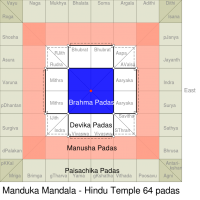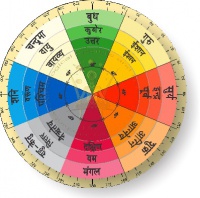Vastu Shastra: Unterschied zwischen den Versionen
Aus Spiritwiki
Adm1 (Diskussion | Beiträge) |
Adm1 (Diskussion | Beiträge) |
||
| Zeile 12: | Zeile 12: | ||
== Literatur == | == Literatur == | ||
[[Datei:Vastu_direction_chakar.jpg|200px|thumb|right|Vastu Richtungs - Kreis ]] | |||
* Acharya P.K. (1946), [https://archive.org/stream/encyclopaediaofh07achauoft#page/n9/mode/2up An Encyclopedia of Hindu Architecture], Oxford University Press - Terminology of Ancient Architecture | * Acharya P.K. (1946), [https://archive.org/stream/encyclopaediaofh07achauoft#page/n9/mode/2up An Encyclopedia of Hindu Architecture], Oxford University Press - Terminology of Ancient Architecture | ||
* [https://books.google.de/books?id=Oo-dCM_pp7wC&redir_esc=y Indian Architectural Theory]: Contemporary Uses of Vastu Vidya, | * [https://books.google.de/books?id=Oo-dCM_pp7wC&redir_esc=y Indian Architectural Theory]: Contemporary Uses of Vastu Vidya, | ||
Version vom 28. Dezember 2016, 12:38 Uhr
Das Vastu shastra (vāstu śāstra) ist ein altes indisches Architektursystem, das einen Teil des Vastu Vidya bildet. Es ist dabei ein Teil des of Sthapatya Veda des Yajurveda.
Die diesbezüglichen Texte beschreiben Konstruktionsprinzipien, Pläne und Masse sowie Aufbereitung der Grundstücke. Die Konstruktionen sollen esoterische Geometrie und spirituelle Prinzipien in Form von Yantras integrieren.
Das antike Vastu Shastra beinhaltet auch die Konstruktionsprinzipien von Tempeln und daneben jeglicher anderer Gebäude bis zu öffentlichen Plätzen.
Literatur
- Acharya P.K. (1946), An Encyclopedia of Hindu Architecture, Oxford University Press - Terminology of Ancient Architecture
- Indian Architectural Theory: Contemporary Uses of Vastu Vidya,
Vibhuti Chakrabarti, Psychology Press, 1998
- Vaastu: The Indian Art of Placement: Design and Decorate Homes to Reflect Eternal Spiritual Principles, Rohit Arya, Inner Traditions / Bear & Co, 2000
Weblinks
- Wiki about the Vastu shastra
- Origin and texts on Vastu Shastra

